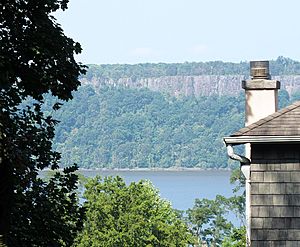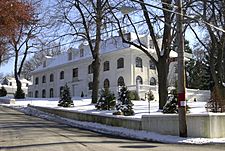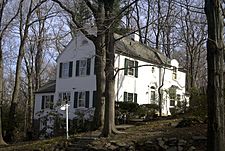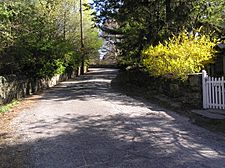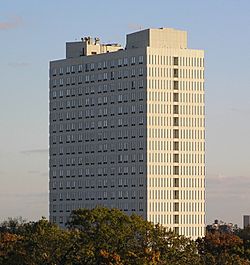Riverdale, Bronx facts for kids
Quick facts for kids
Riverdale
|
|
|---|---|
|
Neighborhood of the Bronx
|
|
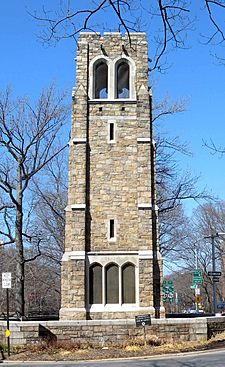
Bell Tower Park in Riverdale
|
|
| Country | |
| State | |
| City | New York City |
| Borough | The Bronx |
| Community District | Bronx 8 |
| Founded | 1852 |
| Named for | The numerous brooks, streams and meadows in the hilly region. |
| Area | |
| • Total | 7.03 km2 (2.714 sq mi) |
| Population
(2010)
|
|
| • Total | 47,850 |
| • Density | 6,807.3/km2 (17,631/sq mi) |
| Economics
Includes Fieldston
|
|
| • Median income (2019) | $64,360 |
| ZIP Codes |
10463, 10471
|
| Area code | 718, 347, 929, and 917 |
Riverdale is a lovely residential neighborhood located in the northwestern part of the Bronx, a borough of New York City. It's known for its many green spaces and beautiful views. In 2000, about 47,850 people lived here. Riverdale is home to the northernmost point of New York City, which is at the College of Mount Saint Vincent.
The neighborhood is generally bordered by Yonkers to the north and the Hudson River to the west. To the east, you'll find Van Cortlandt Park and Broadway. The southern border is either the Harlem River or the Spuyten Duyvil neighborhood. Riverdale Avenue is the main road that runs north and south through the area.
Riverdale is part of Bronx Community Board 8. Its main ZIP Codes are 10463 and 10471. The New York City Police Department's 50th Precinct keeps the area safe.
Contents
Riverdale's Past: A Look Back in Time
Some stories say that in 1664, a man named Anthony Van Corlaer tried to swim across the Harlem River from nearby Spuyten Duyvil and disappeared. Later, in the late 1600s, Frederick Philipse built a bridge called "King's Bridge" across Spuyten Duyvil Creek. He charged people a fee to cross it. This bridge was near where West 230th Street is today.
How Riverdale Grew
In the 1800s, Riverdale became a popular place for rich families from Manhattan to build large country homes. For example, the Fieldston area was once part of a big estate owned by Major Joseph Delafield. He bought the land in 1829.
As railroads became popular, wealthy business people started living in Riverdale all year round. They could easily travel to the city by train. The New York Central and Hudson River Railroad helped the neighborhood grow. The train tracks were later moved to connect with Grand Central Depot in Manhattan, a route still used by the Metro-North Railroad's Hudson Line.
Fieldston's Unique Design
In 1909, the Delafield family planned out the Fieldston area. Instead of straight streets, they used a design that followed the land's natural shape. This helped save many of the trees. The first house was built in 1910. Today, Fieldston is a private community and one of New York City's wealthiest areas. It's known for its beautiful design and green spaces.
Modern Riverdale and Important Events
Over time, more apartment buildings and smaller homes were built in Riverdale. It remains a well-off neighborhood in New York City. Its rich history led to parts of it being named a historic district.
In 2010, a small tornado, called an EF1 tornado, hit Riverdale. Luckily, no one died, but seven people were hurt. In 2013, a train accident near the Spuyten Duyvil station caused some injuries and sadly, four deaths.
Riverdale's Location and Areas
Riverdale covers about 3 square miles (7.8 square kilometers). It has some of the highest points in New York City. From here, you can see the Empire State Building, the George Washington Bridge, the Hudson River, and the New Jersey Palisades. The area is also famous for its many parks and green forests.
Riverdale is bordered by Yonkers to the north and the Hudson River to the west. Its eastern and southern borders are sometimes debated. Many people agree that Broadway is the eastern border and the Harlem River is the southern one.
Riverdale has several smaller sections within it:
- Central Riverdale: This is like the "downtown" area.
- Fieldston: Known for its beautiful homes and green spaces.
- Hudson Hill: This area has many historic mansions.
- North Riverdale: The northernmost part of the neighborhood.
- Mosholu: Located east of Fieldston Road.
- Spuyten Duyvil / South Riverdale: The southernmost part, including a busy shopping area.
- Villanova Heights: A smaller area with specific borders.
Both Fieldston and a 15-acre area called the Riverdale Historic District are protected as historic districts. This means their special character is preserved.
Who Lives in Riverdale: Population Details
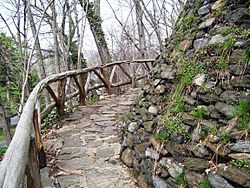
In 2010, Riverdale had a population of 27,860 people. Most residents are White (67.5%), with smaller groups of African American (7.7%), Asian (5.3%), and Hispanic or Latino (17.6%) people. Riverdale also has a large Jewish community. In 2003, most of the Jewish people in the Bronx lived in Riverdale.
The average life expectancy in Riverdale is about 80.9 years. Most people living here are young or middle-aged adults. In 2017, the average household income was $53,986. About 15% of Riverdale residents live in poverty, which is lower than the average for the Bronx and New York City.
Homes in Riverdale
Riverdale has many different types of homes. You can find modern houses like the Saul Victor house, designed in 1967. The Hudson Hill area has famous old mansions like Greyston (built in 1864) and Stonehurst (built in 1861).
Before Riverdale grew widely, it had large, beautiful mansions. These homes were often built in styles like Georgian and Tudor, making the area feel like a countryside. Many of these grand homes are in the Fieldston section. You can also find more affordable older buildings and smaller houses throughout Riverdale.
In the 1950s and 1960s, many brick apartment buildings were built. Some of these were tall towers with doormen, designed by architect Philip Birnbaum. By the 1980s, many apartment buildings became cooperatives, meaning residents owned their apartments. Riverdale mostly has owner-occupied homes.
The Arbor: Columbia University Housing
In 2008, Columbia University bought an apartment building called The Arbor. It is located at 3260 Henry Hudson Parkway. This building is used to house Columbia students who take classes at different university campuses. Students can rent apartments with one to three bedrooms for a year.
A special shuttle bus, called the Arbor Shuttle, helps students travel between The Arbor and the university's main campuses. It runs on weekdays.
Gallery of Riverdale Homes
-
Lou Gehrig's house
Local News and Safety
Media
The Riverdale Press is a weekly newspaper that shares news important to the people living in Riverdale. It has even won a Pulitzer Prize!
Fire Safety
Riverdale has its own fire station, Engine Co. 52/Ladder Co. 52. It is located at 4550 Henry Hudson Parkway East. This is the only firehouse in Riverdale and the northernmost one operated by the New York City Fire Department (FDNY).
Mail and Education
Post Offices and ZIP Codes
Riverdale uses two ZIP Codes: 10471 for the northern part and 10463 for the southern part. The United States Postal Service has three post offices nearby:
- Riverdale Station – 5951 Riverdale Avenue
- Fieldston Station – 444 West 238th Street
- Spuyten Duyvil Station – 444 West 238th Street
Learning in Riverdale
Riverdale has a good number of college-educated residents, similar to the rest of New York City. About 45% of adults aged 25 and older have a college degree or higher. The percentage of students doing well in math and reading has also increased over the years.
Riverdale's elementary school students miss about the same number of school days as students across New York City. Also, 78% of high school students in Riverdale graduate on time, which is higher than the city average.
Public Schools
Public schools in Riverdale are part of the New York City Department of Education.
- Elementary Schools: The Spuyten Duyvil School (P.S. 24) and the Robert J. Christen School (P.S. 81).
- Middle and High School: The Riverdale Kingsbridge Academy (M.S./H.S 141).
- Nearby High Schools: Other public high schools serving the community include the Bronx High School of Science (a special high school), John F. Kennedy High School Campus, and the IN-Tech Academy MS/HS 368.
Private Schools
Riverdale is home to several excellent private schools:
- Horace Mann
- Riverdale Country
- Fieldston
These schools are all members of the Ivy Preparatory School League.
The neighborhood also has two Roman Catholic colleges:
- The University of Mount Saint Vincent
- Manhattan University
Because of the growing Jewish population, Riverdale also has highly-rated Jewish day schools:
- The SAR Academy (elementary school)
- The SAR High School
- Kinneret Day School (pre-K through 8th grade)
Other religious schools include:
- Yeshivas: The Yeshiva of Telshe Alumni, Yeshiva Ohavei Torah, Yeshivat Chovevei Torah, and Yeshivat Maharat.
- Catholic Elementary Schools: Visitation School, St. Gabriel's School, and St. Margaret of Cortona School, where President John F. Kennedy received his Confirmation.
The Russian Mission School in New York is also located in Riverdale.
Preschools
Riverdale has many preschools, including BedRock Preschool, Kinneret Day School's Nursery, Riverdale Temple Nursery School, Spuyten Duyvil Preschool, SAR Academy (Early Learning Center), Riverdale Nursery School and Family Center, Riverdale Presbyterian Church Nursery School, and Riverdale Montessori School.
Libraries
The New York Public Library (NYPL) has three branches close to Riverdale:
- Van Cortlandt branch: Located at 3882 Cannon Place. It opened in 2019.
- Riverdale branch: Located at 5540 Mosholu Avenue. It opened in 1967.
- Spuyten Duyvil branch: Located at 650 West 235th Street. It opened in 1971.
Getting Around Riverdale: Transportation
Public Transportation
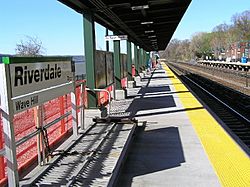
Riverdale is well-connected by public transportation.
- MTA Buses: Several MTA Regional Bus Operations routes serve Riverdale, connecting it to other parts of the Bronx and Manhattan. These include the Bx1, Bx7, Bx9, Bx10, and Bx20. There are also express buses (BxM1, BxM2, BxM3, BxM18) that go to Midtown and Lower Manhattan.
- Columbia Transportation: The Arbor Shuttle and Queens Riverdale Commuter Route also serve the area.
- Subway: The 1 train of the New York City Subway stops at three stations in or near Riverdale:
* 231st Street * 238th Street * Van Cortlandt Park–242nd Street
- Bee-Line Buses: These routes connect Riverdale to Westchester County.
- Metro-North Railroad: Commuter train service is available at two stations on the Hudson Line:
* The Spuyten Duyvil station * The Riverdale station * The Hudson Rail Link connects these stations to the surrounding neighborhoods.
Roads
By car, you can reach Riverdale using the Henry Hudson Parkway (NY 9A) via the Henry Hudson Bridge. You can also use Broadway (US 9) via the Broadway Bridge.
Fun Places and Important Spots
Parks
- Bell Tower Park: This park has the Riverdale Monument, a stone memorial built in 1930 to honor those who served in World War I.
- Brust Park: A 1.8-acre park maintained by volunteers from the community and Manhattan University.
- Gaelic Park: Owned by Manhattan University, this park is home to many sports teams, including lacrosse, soccer, and softball. It's also where Gaelic football and hurling are played in New York.
- Riverdale Waterfront Promenade: A small park along the Hudson River near the Riverdale Metro-North train station. It offers public views of the Hudson River.
- Seton Park: This park has a large green space, tennis courts, baseball fields, and playgrounds.
- Wave Hill: A beautiful 20-acre botanical garden and outdoor art gallery overlooking the Hudson River. Famous people like Theodore Roosevelt and Mark Twain once used this property. It's known as one of New York City's most beautiful parks.
Places of Worship
- Chabad of Riverdale
- Christ Church Riverdale
- Church of the Visitation
- Congregation Tehillah
- Conservative synagogue Adath Israel of Riverdale
- Edgehill Church at Spuyten Duyvil
- Hebrew Institute of Riverdale
- Riverdale Jewish Center
- Riverdale Presbyterian Church
- Riverdale Temple
- St. Gabriel's Roman Catholic Church
- Saint Margaret of Cortona Church
- St Peter's Greek Orthodox Church
- Young Israel of Riverdale
- Young Israel Ohab Tzedek
- Kehilah of Riverdale
Community Groups
- Bronx Community Board 8: A group of local people who help make decisions about city services and land use in the community.
- Riverdale Hatzalah Volunteer Ambulance Corp.: Provides free medical help and transport, supported by community donations.
- Riverdale YM-YWHA: A community center with activities for kids, teens, adults, and seniors.
- Riverdale Children's Theater: A local theater company that puts on musicals and offers theater programs.
Museums
- Derfner Judaica Museum: This museum has a collection of about 1,400 objects used in Jewish ceremonies, along with Jewish art.
- Wave Hill: Besides being a botanical garden, Wave Hill also has two historic mansions with art exhibitions and concerts.
Famous People from Riverdale
- Sean Altman (born 1961), musician and founder of Rockapella
- William Henry Appleton (1814–1899), publisher, lived at Wave Hill
- Béla Bartók (1881–1945), composer
- Mario Biaggi (1917–2015), decorated policeman and US Congressman
- Jonathan Brewster Bingham (1914–1986), member of the House of Representatives
- Ron Blomberg (born 1948), first designated hitter in baseball history
- Alexander Calder (1898–1976), sculptor
- Chris Chambliss (born 1948), former baseball player
- Ella Fitzgerald (1917–1996), jazz singer
- Julia Garner (born 1994), actress
- Lou Gehrig (1903–1941), New York Yankees baseball player
- Jordan Gelber (born 1975), actor
- Mark Goodman (born 1952), one of the original MTV VJs
- Nat Holman (1896–1995), Hall of Fame basketball player
- Eric Kandel (born 1929), Columbia University neuroscientist, Nobel laureate
- Ida Keeling (born 1915), runner, World Record holder
- Eunice Kennedy (1921–2009), founder of the Special Olympics
- John F. Kennedy (1917–1963), U.S. president, lived in Riverdale as a child
- Joseph P. Kennedy Sr. (1888–1969), important member of the Kennedy Family
- Robert F. Kennedy (1925–1968), U.S. Senator and Attorney General
- Theodore W. Kheel (1914–2010), labor lawyer
- Fiorello H. La Guardia (1882–1947), Mayor of New York City
- Jack Lew (born 1955), United States Secretary of the Treasury
- Willie Mays (born 1931), baseball star
- Tracy Morgan (born 1968), comedian and actor
- George Walbridge Perkins (1862–1920), first president of the Palisades Interstate Park Commission
- Alfonso Ribeiro (born 1971), actor and dancer
- Theodore Roosevelt Sr. (1831–1878), banker and father of the U.S. President
- Ben Schwartz (born 1981), comedic actor
- Carly Simon (born 1943), singer/songwriter
- Eliot Spitzer (born 1959), former Governor of New York
- U Thant (1909–1974), former United Nations Secretary-General
- Arturo Toscanini (1867–1957), conductor
- Mark Twain (1835–1910), author
- Steven Tyler (born 1948), lead singer of rock band Aerosmith
- Neil deGrasse Tyson (born 1958), astrophysicist and television host
- Rebecca Walker (born 1969), writer
- Rosalyn Sussman Yalow (1921–2011), Nobel laureate
See also
 In Spanish: Riverdale (Nueva York) para niños
In Spanish: Riverdale (Nueva York) para niños


